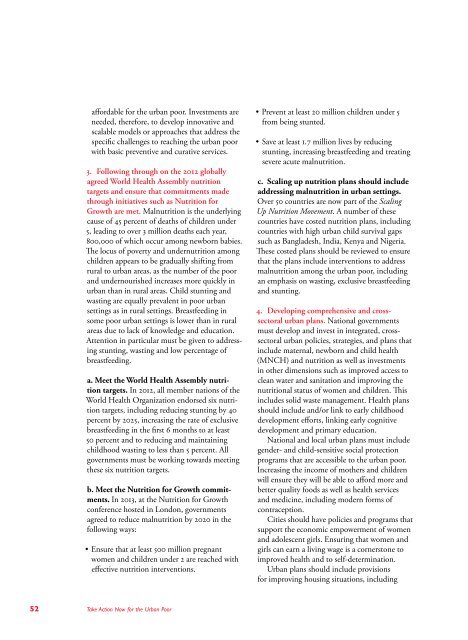sowm_2015__int__africa_full_report_low_res
sowm_2015__int__africa_full_report_low_res
sowm_2015__int__africa_full_report_low_res
You also want an ePaper? Increase the reach of your titles
YUMPU automatically turns print PDFs into web optimized ePapers that Google loves.
affordable for the urban poor. Investments are<br />
needed, therefore, to develop innovative and<br />
scalable models or approaches that add<strong>res</strong>s the<br />
specific challenges to reaching the urban poor<br />
with basic preventive and curative services.<br />
3. Fol<strong>low</strong>ing through on the 2012 globally<br />
agreed World Health Assembly nutrition<br />
targets and ensure that commitments made<br />
through initiatives such as Nutrition for<br />
Growth are met. Malnutrition is the underlying<br />
cause of 45 percent of deaths of children under<br />
5, leading to over 3 million deaths each year,<br />
800,000 of which occur among newborn babies.<br />
The locus of poverty and undernutrition among<br />
children appears to be gradually shifting from<br />
rural to urban areas, as the number of the poor<br />
and undernourished increases more quickly in<br />
urban than in rural areas. Child stunting and<br />
wasting are equally prevalent in poor urban<br />
settings as in rural settings. Breastfeeding in<br />
some poor urban settings is <strong>low</strong>er than in rural<br />
areas due to lack of knowledge and education.<br />
Attention in particular must be given to add<strong>res</strong>sing<br />
stunting, wasting and <strong>low</strong> percentage of<br />
breastfeeding.<br />
a. Meet the World Health Assembly nutrition<br />
targets. In 2012, all member nations of the<br />
World Health Organization endorsed six nutrition<br />
targets, including reducing stunting by 40<br />
percent by 2025, increasing the rate of exclusive<br />
breastfeeding in the first 6 months to at least<br />
50 percent and to reducing and ma<strong>int</strong>aining<br />
childhood wasting to less than 5 percent. All<br />
governments must be working towards meeting<br />
these six nutrition targets.<br />
b. Meet the Nutrition for Growth commitments.<br />
In 2013, at the Nutrition for Growth<br />
conference hosted in London, governments<br />
agreed to reduce malnutrition by 2020 in the<br />
fol<strong>low</strong>ing ways:<br />
• Ensure that at least 500 million pregnant<br />
women and children under 2 are reached with<br />
effective nutrition <strong>int</strong>erventions.<br />
• Prevent at least 20 million children under 5<br />
from being stunted.<br />
• Save at least 1.7 million lives by reducing<br />
stunting, increasing breastfeeding and treating<br />
severe acute malnutrition.<br />
c. Scaling up nutrition plans should include<br />
add<strong>res</strong>sing malnutrition in urban settings.<br />
Over 50 countries are now part of the Scaling<br />
Up Nutrition Movement. A number of these<br />
countries have costed nutrition plans, including<br />
countries with high urban child survival gaps<br />
such as Bangladesh, India, Kenya and Nigeria.<br />
These costed plans should be reviewed to ensure<br />
that the plans include <strong>int</strong>erventions to add<strong>res</strong>s<br />
malnutrition among the urban poor, including<br />
an emphasis on wasting, exclusive breastfeeding<br />
and stunting.<br />
4. Developing comprehensive and crosssectoral<br />
urban plans. National governments<br />
must develop and invest in <strong>int</strong>egrated, crosssectoral<br />
urban policies, strategies, and plans that<br />
include maternal, newborn and child health<br />
(MNCH) and nutrition as well as investments<br />
in other dimensions such as improved access to<br />
clean water and sanitation and improving the<br />
nutritional status of women and children. This<br />
includes solid waste management. Health plans<br />
should include and/or link to early childhood<br />
development efforts, linking early cognitive<br />
development and primary education.<br />
National and local urban plans must include<br />
gender- and child-sensitive social protection<br />
programs that are accessible to the urban poor.<br />
Increasing the income of mothers and children<br />
will ensure they will be able to afford more and<br />
better quality foods as well as health services<br />
and medicine, including modern forms of<br />
contraception.<br />
Cities should have policies and programs that<br />
support the economic empowerment of women<br />
and adolescent girls. Ensuring that women and<br />
girls can earn a living wage is a cornerstone to<br />
improved health and to self-determination.<br />
Urban plans should include provisions<br />
for improving housing situations, including<br />
52 Take Action Now for the Urban Poor




